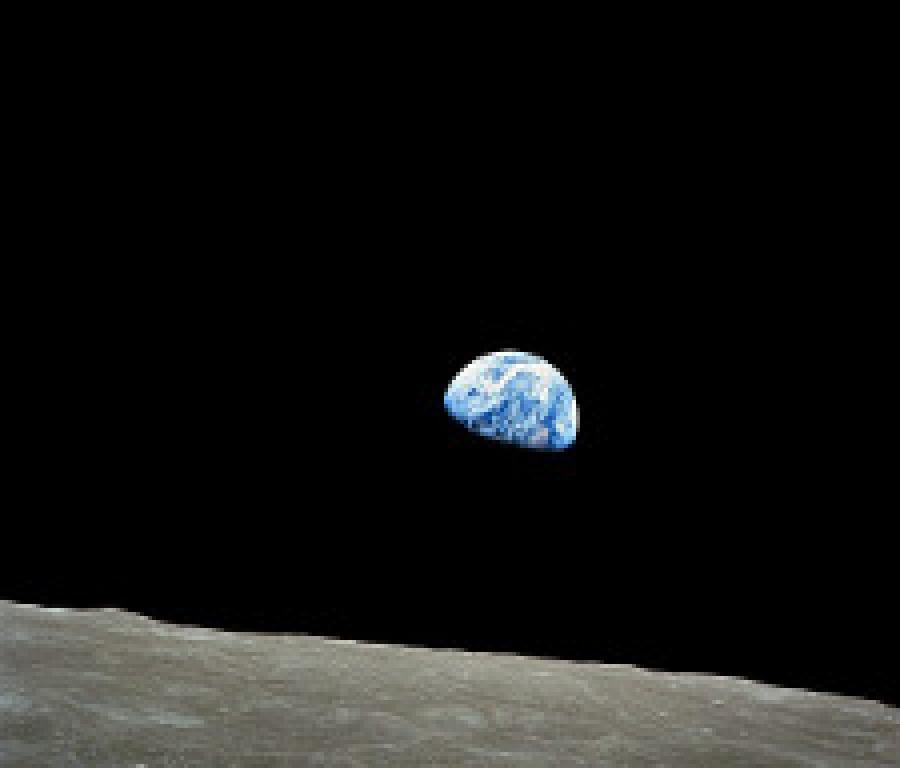Essential Elements of Young Earth Creationism and Their Importance to Christian Theology (Part 2)
Image

"Earthrise." NASA photo, Apollo 8.
From DBSJ. Read the series. Part 2 continues the Spectrum of Views on Creation begun in Part 1.
Scientific Creationism
Compared to biblical creation views, scientific creationist views expand the role of science in the understanding of creation. The views that fall under this heading are normally connected with a uniformitarian view of earth history that extends billions of years, punctuated by occasional catastrophic events.9 These are old-earth understandings of creation. The scientific views are different in another way from biblical creation: most do not posit a completed creation. The processes of creation (evolution) are ongoing today in most of the following views and therefore there is no “completion” or “cessation” of creation as there is in the biblical creation views.
The day-age view is an old-earth explanation that teaches that the six days of creation were not regular days but rather were a sequence of geological ages, giving time for the several-billion year age of the earth taught by secular science.
Theistic evolution is an old-earth view that teaches that God created inorganic materials and set in place laws and properties that would, with time and evolutionary processes, yield the result of creation that we see today. It is also called the fully gifted creation view or evolutionary creationism.10 Macro-evolution is true on this view, but its processes were created and initiated by God.
Old earth progressive creationism is a modification of the theistic evolution view that suggests God intervened at various key points to modify existing species or to specially create new species.11 Accordingly, the problem of missing transitional evolutionary forms is eliminated since God “filled” those gaps with his supernatural creative work.
The old earth framework understanding of creation explains that the creation account of Genesis is a poetic, pictorial, and careful arrangement of the events of creation. The events are not given in sequential or literal order but are rather designed to express God’s orderly creation of spheres and subsequent filling of those spheres with living things, followed by his Sabbath rest.12 Technically, the framework theory says that Genesis does not provide specifics on the age of the earth or other such details. Practically, it is a doctrine that attempts to harmonize the Bible with science.
The secular evolutionary theory is an old earth, non-theistic evolutionary model. Purely natural processes brought about all that exists, except perhaps the remarkable beginning at the Big Bang. Random mutations are filtered through natural selection to produce various life forms of increasing complexity over vast periods of time.
Summary of Views on Creation
At somewhat of a risk of oversimplification, the chart below shows a pictorial summary of the various views and how they are distinguished form one another (○ = no, ● = yes, ◒ = partial or “in some variations”).

Notes
9 Before the advent of modern uniformitarianism, there were basically no Christian commentators who suggested that creation took millions of years. This is demonstrated convincingly in the first three chapters of Coming to Grips with Genesis: Biblical Authority and the Age of the Earth, ed. Terry Mortenson and Thane H. Ury (Green Forest, AR: Master Books, 2008).
10 Howard J. Van Till, “The Fully Gifted Creation,” in Three Views on Creation and Evolution, ed. J. P. Moreland & John Mark Reynolds (Grand Rapids: Zondervan, 1999), 161–218. The Biologos organization promotes this view (www.biologos.org).
11 For a summary and refutation of this view, see Jonathan Sarfati, Refuting Compromise: A Biblical and Scientific Refutation of “Progressive Creationism” (Billions of Years), As Popularized by Astronomer Hugh Ross (Green Forest, AR: Master Books, 2004).
12 Meredith Kline, “Because It Had Not Rained,” Westminster Theological Journal 20 (1958): 147–57. For an excellent critique, see McCabe’s “A Critique of the Framework Interpretation of the Creation Week,” in Coming to Grips with Genesis: Biblical Authority and the Age of the Earth, ed. Terry Mortenson and Thane H. Ury (Green Forest, AR: Master Books: 2008), 211–49.
Matthew Postiff Bio
Dr. Postiff has served as Pastor of Fellowship Bible Church since 2006. He holds a PhD in computer engineering from University of Michigan and ran an engineering consulting firm specializing in design and simulation of computer microprocessors. He earned his ThM from Detroit Baptist Theological Seminary in 2010.
- 61 views
A useful diagram. Thanks!
Dr. Paul Henebury
I am Founder of Telos Ministries, and Senior Pastor at Agape Bible Church in N. Ca.
One caveat that I would point out is that elements of the Big Bang Cosmology can be aligned with YEC. Most YEC would or may concede with the fact that the initial creation of the heavens and the earth could have occurred in much the same way as what may look like a Big Bang. What we would contend with is the billions of years that have been layered on top of the Big Bang Cosmology. 9 of the 14 epochs related to the Big Bang, all occurred in less than 1 day. And there is still a very large amount of missing knowledge below 10^-43 seconds, because of a lack of our ability to create a scientific model below that range. 5 of the 14 epochs took place in less than 1 second.




Discussion